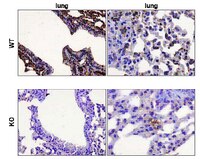Hypermethylated in cancer 1 (HIC1), a tumor suppressor gene epigenetically deregulated in hyperparathyroid tumors by histone H3 lysine modification.
Svedlund, J; Koskinen Edblom, S; Marquez, VE; Åkerström, G; Björklund, P; Westin, G
J Clin Endocrinol Metab
97
E1307-15
2012
Show Abstract
Primary hyperparathyroidism (pHPT) resulting from parathyroid tumors is a common endocrine disorder with incompletely understood etiology. In renal failure, secondary hyperparathyroidism (sHPT) occurs with multiple tumor development as a result of calcium and vitamin D regulatory disturbance.The aim of the study was to investigate whether HIC1 may act as a tumor suppressor in the parathyroid glands and whether deregulated expression involves epigenetic mechanisms.Parathyroid tumors from patients with pHPT included single adenomas, multiple tumors from the same patient, and cancer. Hyperplastic parathyroid glands from patients with sHPT and hypercalcemia and normal parathyroid tissue specimens were included in the study. Quantitative RT-PCR, bisulfite pyrosequencing, colony formation assay, chromatin immunoprecipitation, and RNA interference was used.HIC1 was generally underexpressed regardless of the hyperparathyroid disease state including multiple parathyroid tumors from the same patient, and overexpression of HIC1 led to a decrease in clonogenic survival of parathyroid tumor cells. Only the carcinomas showed a high methylation level and reduced HIC1 expression. Cell culture experiments, including use of primary parathyroid tumor cells prepared directly after operation, the general histone methyltransferase inhibitor 3-deazaneplanocin A, chromatin immunoprecipitation, and RNA interference of DNA methyltransferases and EZH2 (enhancer of zeste homolog 2), supported a role of repressive histone H3 modifications (H3K27me2/3) rather than DNA methylation in repression of HIC1.The results strongly support a growth-regulatory role of HIC1 in the parathyroid glands and suggest that perturbed expression of HIC1 may represent an early event during tumor development. Repressive histone modification H3K27me2/3 is involved in repression of HIC1 expression in hyperparathyroid tumors. | 22544915
 |
MiR-129-5p is required for histone deacetylase inhibitor-induced cell death in thyroid cancer cells.
Brest, P; Lassalle, S; Hofman, V; Bordone, O; Gavric Tanga, V; Bonnetaud, C; Moreilhon, C; Rios, G; Santini, J; Barbry, P; Svanborg, C; Mograbi, B; Mari, B; Hofman, P
Endocrine-related cancer
18
711-9
2011
Show Abstract
The molecular mechanism responsible for the antitumor activity of histone deacetylase inhibitors (HDACi) remains elusive. As HDACi have been described to alter miRNA expression, the aim of this study was to characterize HDACi-induced miRNAs and to determine their functional importance in the induction of cell death alone or in combination with other cancer drugs. Two HDACi, trichostatin A and vorinostat, induced miR-129-5p overexpression, histone acetylation and cell death in BCPAP, TPC-1, 8505C, and CAL62 cell lines and in primary cultures of papillary thyroid cancer (PTC) cells. In addition, miR-129-5p alone was sufficient to induce cell death and knockdown experiments showed that expression of this miRNA was required for HDACi-induced cell death. Moreover, miR-129-5p accentuated the anti-proliferative effects of other cancer drugs such as etoposide or human α-lactalbumin made lethal for tumor cells (HAMLET). Taken together, our data show that miR-129-5p is involved in the antitumor activity of HDACi and highlight a miRNA-driven cell death mechanism. | 21946411
 |
Inhibition of nuclear factor-kappa B differentially affects thyroid cancer cell growth, apoptosis, and invasion.
Bauerle KT, Schweppe RE, Haugen BR
Mol Cancer
9
117.
2010
Show Abstract
BACKGROUND: Nuclear factor-kappaB (NF-kappaB) is constitutively activated in many cancers and plays a key role in promoting cell proliferation, survival, and invasion. Our understanding of NF-kappaB signaling in thyroid cancer, however, is limited. In this study, we have investigated the role of NF-kappaB signaling in thyroid cancer cell proliferation, invasion, and apoptosis using selective genetic inhibition of NF-kappaB in advanced thyroid cancer cell lines. Full Text Article | 20492683
 |
Structural and functional analysis of poly(ADP ribose) polymerase: an immunological study.
Lamarre, D, et al.
Biochim. Biophys. Acta, 950: 147-60 (1988)
1988
Show Abstract
Poly(ADP ribose) polymerase (EC 2.4.2.30) was studied using monoclonal antibodies for three different epitopes on the enzyme. The epitopes were mapped in relation to the functional domains of the protein and the inhibitory properties of the antibodies. The intranuclear and interspecies immunoreactivity of the enzyme was also investigated. The epitope of antibody 2 was mapped to the 17 kDa fragment generated by chymotryptic digestion of the C-terminal 54 kDa NAD-binding domain. Antibody 9 binds to the N-terminal 29 kDa fragment of the DNA binding domain and inhibits the enzyme activity by 80%. This antibody was used to purify poly(ADP ribose) polymerase by immunoaffinity chromatography. The third antibody binds to a central 36 kDa fragment that possesses part of the DNA-binding domain and the automodification domain. This antibody increases the enzymatic activity by 30%. An analysis of the species cross-reactivity of the antibodies was carried out by immunoblot analysis of nuclear proteins. Antibody 10 binding was detected in rat FR3T3 cells, Chinese hamster ovary cells (CHO) and epidermoid carcinoma lung human cells (CALU-1). The other two antibodies are specific for the human and bovine enzymes. Western blot analysis showed the association of poly(ADP ribose) polymerase with residual nuclear material obtained after nuclease treatment and high-salt extraction. Immunofluorescence studies with the three different monoclonals demonstrated that accessibility of the epitopes varies in the nucleus. | 2454668
 |













